New Chapter of the Regulation on Monopoly Agreements
To conform to the Decision of the First Session of the 13th National People's Congress on the Institutional Reform Plan of the State Council and comprehensively integrate the anti-monopoly regulatory powers and responsibilities, the State Administration for Market Regulation issued the Interim Provisions on the Prohibition of Monopoly Agreements (“No.10 Document”) on June 26, 2019, which will come into effect on September 1, 2019. Upon the implementation of the No. 10 Document, the original Provisions on the Procedures for the Administrative Organs for Industry and Commerce to Investigate Cases Concerning Monopoly Agreements and Abuses of Dominant Market Positions (“No. 42 Document”) and Provisions of the Industry and Commerce Administration Organs on Prohibition of Monopoly Agreements (“No.53 Document”) will be abolished.
This article concludes and summarizes the changes of the law enforcement in the field of anti-monopoly before and after the implementation of the No.10 Document, aiming to rapidly expound the current regulatory situation.
I. Achieving the “3 in 1” Regulatory Pattern from a Regulatory Perspective
Previously, the Ministry of Commerce, the National Development and Reform Commission and the State Administration for Industry and Commerce are respectively responsible for the law enforcement of anti-monopoly cases. The Ministry of Commerce is responsible to investigate the concentration of undertakings. The National Development and Reform Commission is responsible to investigate the price-related monopolistic acts. The State Administration for Industry and Commerce is responsible to investigate the non-price monopolistic acts.
After the implementation of the No.10 Document, the
law enforcement work of anti-monopoly, from a regulatory perspective, will be centralized
to the State Administration for Market Regulation. The State Administration for
Market Regulation may authorize the market regulation departments of relevant provinces,
autonomous regions and municipalities directly under the central government to
be responsible for the anti-monopoly law enforcement against monopoly
agreements within their respective administrative regions.

II. Establishing the Principle of General Authorization
Previously, according to the No. 42 Document, the State Administration for Industry and Commerce shall be responsible for investigating the non-price monopoly cases which have significant impact nationwide and which it deems should be under its jurisdiction. For the non-price monopoly cases occurring within certain administrative districts or occurring across other provinces, autonomous regions or municipalities directly under the central government, yet the administrative region is the main place where the conducts occur, the State Administration for Industry and Commerce may, case by case, authorize the Administration for Industry and Commerce at the provincial level to investigate the case.
After the implementation of the No.10 Document, the State Administration for Market Regulation is responsible for investigating the monopoly agreement cases (1) occurring across other provinces, autonomous regions or municipalities directly under the central government; (2) which are relatively complicated or have significant impact nationwide; and (3) which it considers as necessary to investigate directly. With respect to the above-mentioned monopoly agreement cases, the State Administration for Market Regulation may designate the relevant market regulation department at the provincial level to investigate them.
In short, before the implementation of the No.10 Document, the authorization is granted case by case. After the implementation of the No.10 Document, the authorization is generally granted.
III. Non- distinction of Price-related Monopoly and Non-price Monopoly
Under the previous joint regulation pattern of three departments, the National Development and Reform Commission was responsible for investigating the price-related monopoly agreements and accordingly, the National Development and Reform Commission enacted and promulgated the Provisions on Anti-price Monopoly and Regulations on Procedures for Administrative Enforcement of Anti-Price Monopoly. Monopoly agreements in other forms were determined by the State Administration for Industry and Commerce according to Provisions of the Industry and Commerce Administration Organs on Prohibition of Monopoly Agreements (i.e. the No. 53 Document).
The No.53 Document will be abolished after the implementation of the No.10 Document. With respect to the two documents, i.e. the Provisions on Anti-price Monopoly and Regulations on Procedures for Administrative Enforcement of Anti-Price Monopoly, although it is not explicitly mentioned in the No.10 Document, considering that the National Development and Reform Commission no longer has the function of investigating monopolistic acts, strictly speaking, the Provisions on Anti-price Monopoly and Regulations on Procedures for Administrative Enforcement of Anti-Price Monopoly will no longer be applicable.
From September 1, 2019, no matter whether prices are concerned or not, monopoly agreements in whichever form will be investigated by the State Administration for Market Regulation and/or the market regulation departments at principal level.
IV. Continuing to Use and Elaborating Some Provisions of the Anti-monopoly Law
1. Continuing to use the definition of “monopoly
agreement” in the No.53 Document, and expanding the types of monopoly agreements.
Please check the below chart.
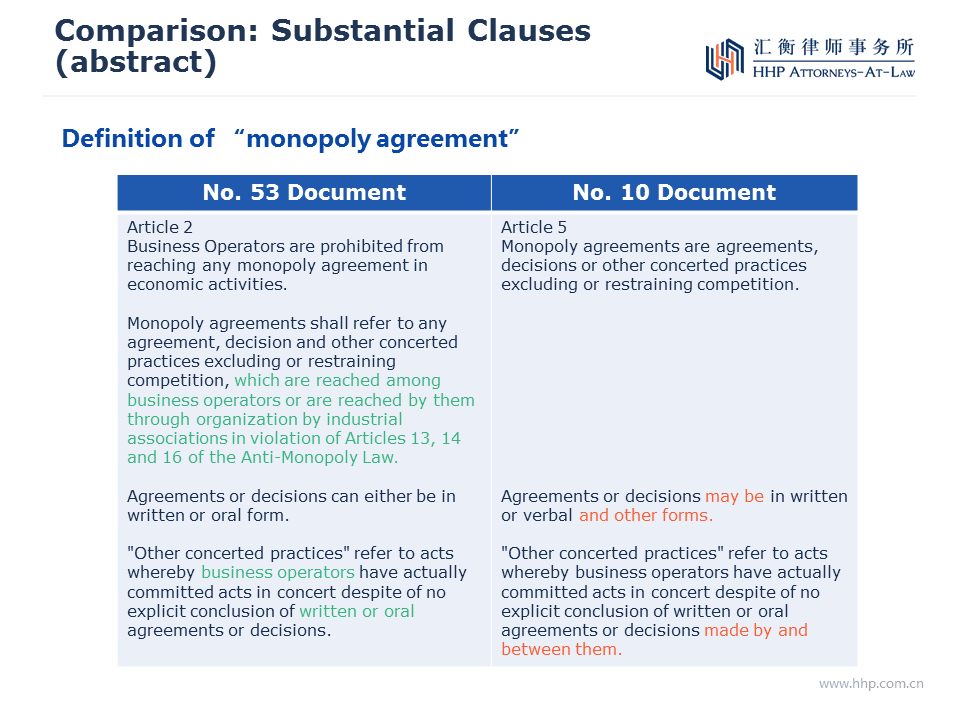
2. Supplementing and elaborating seven types of monopoly agreements stipulated in the Anti-monopoly Law. A specific comparison is as follows:
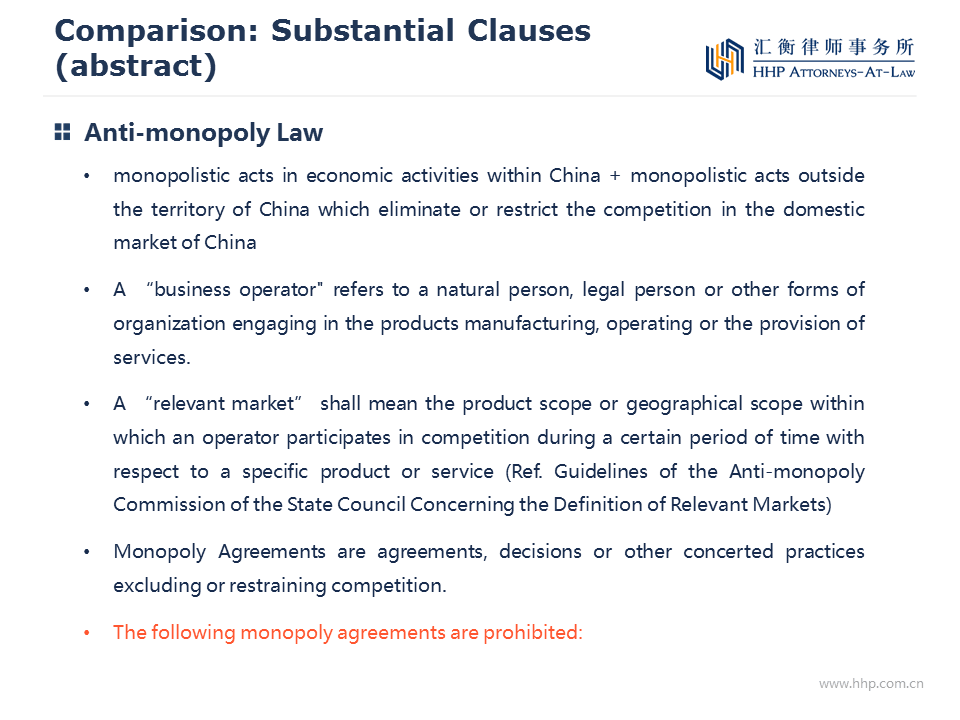
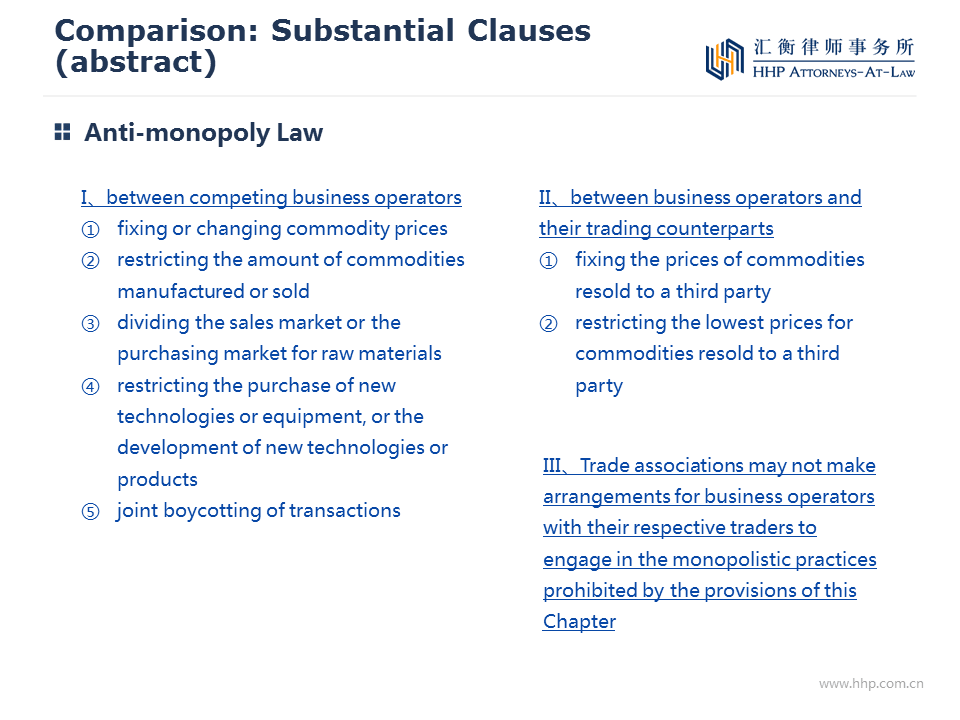

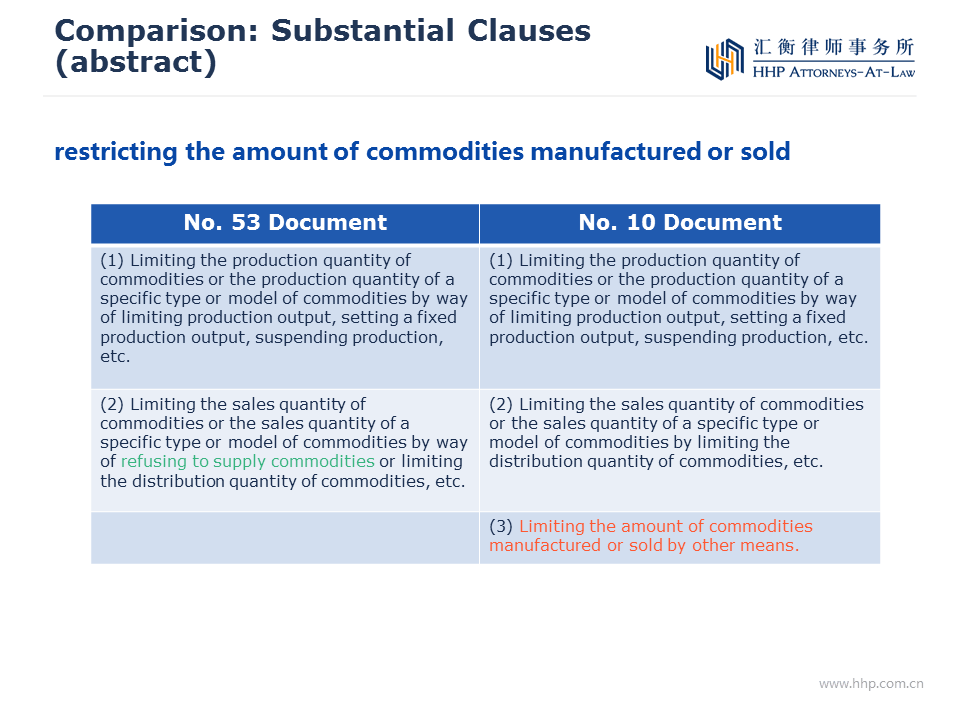
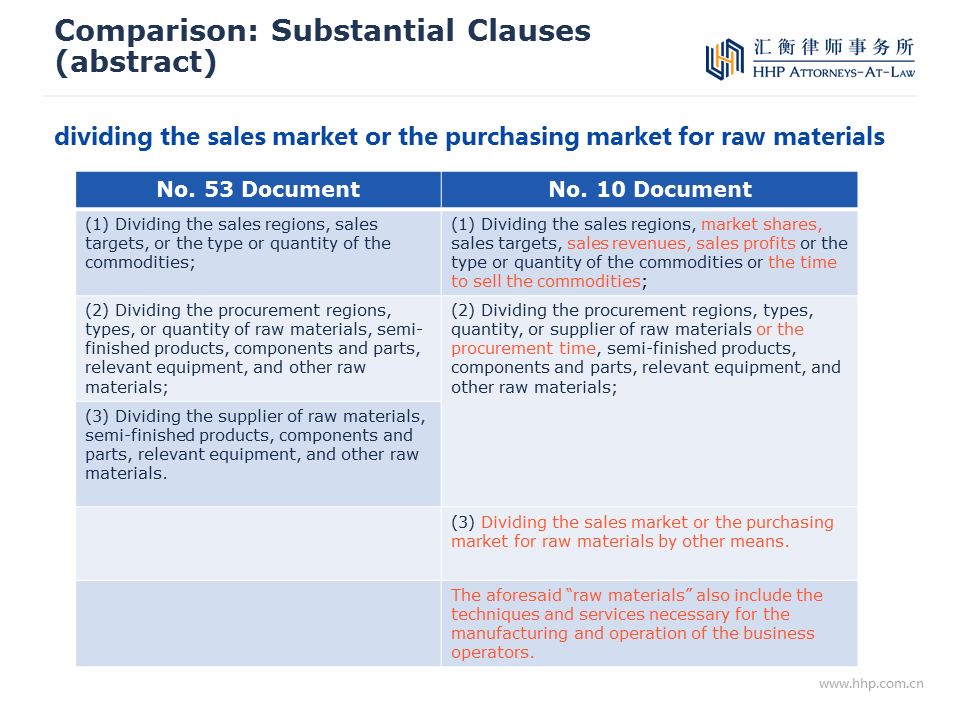
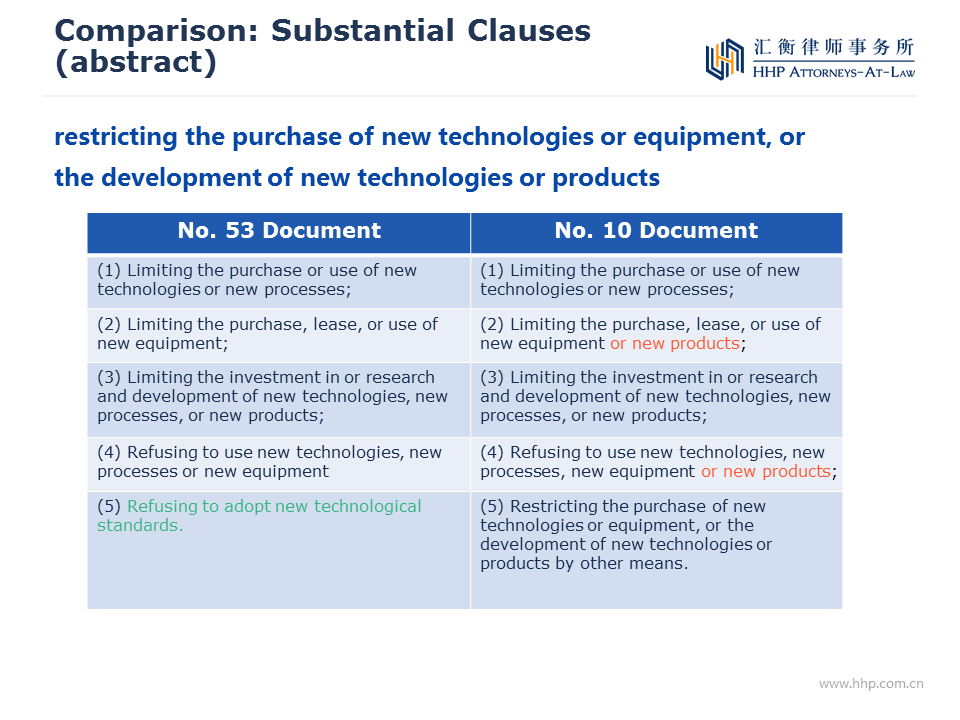
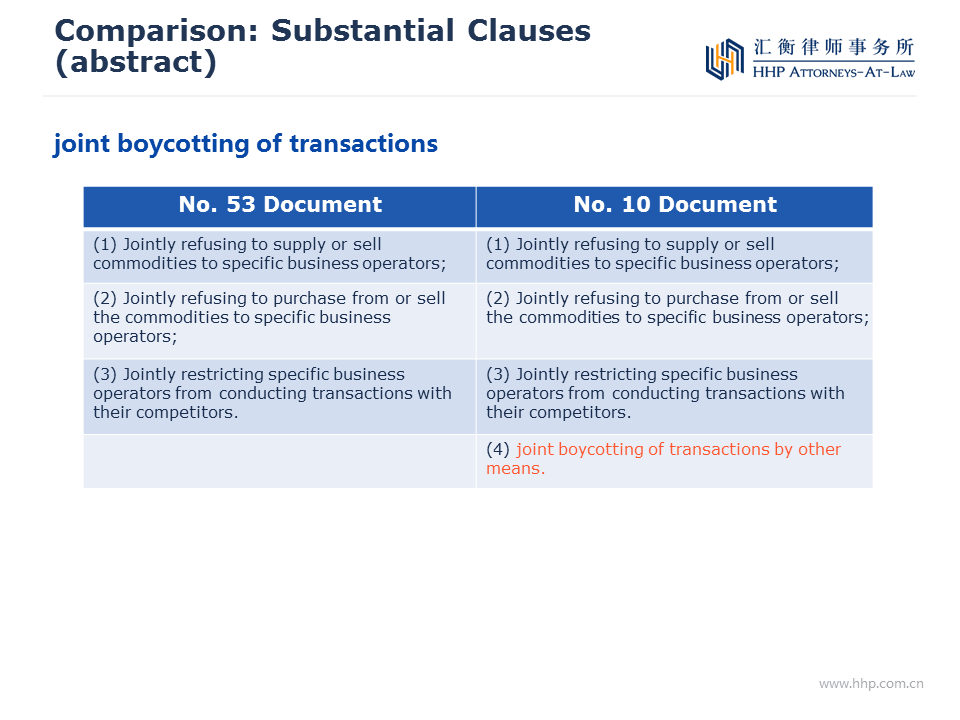
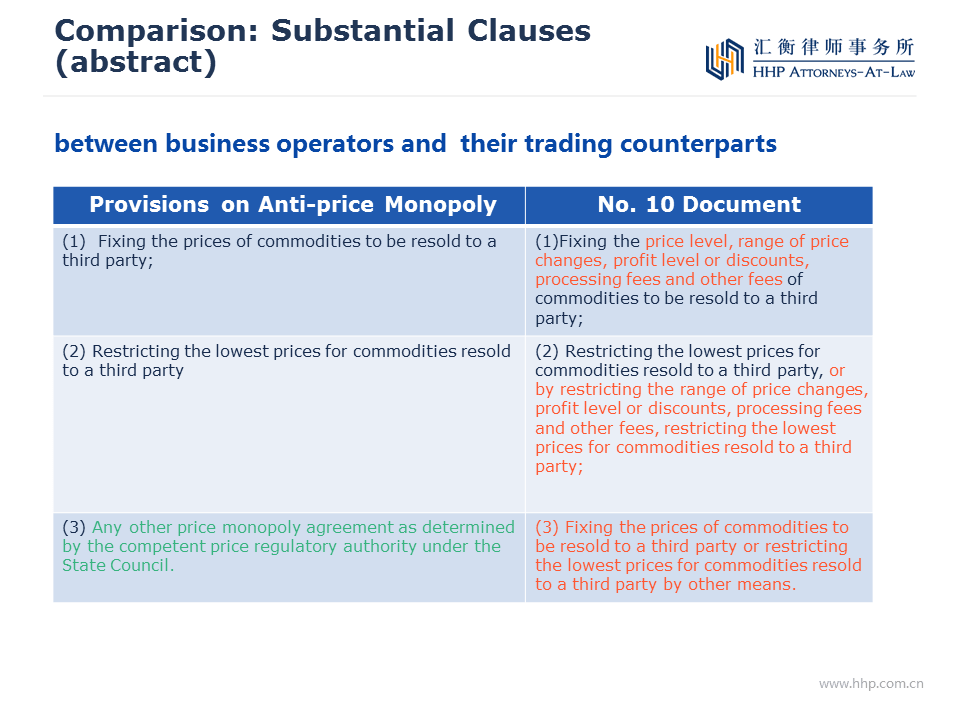
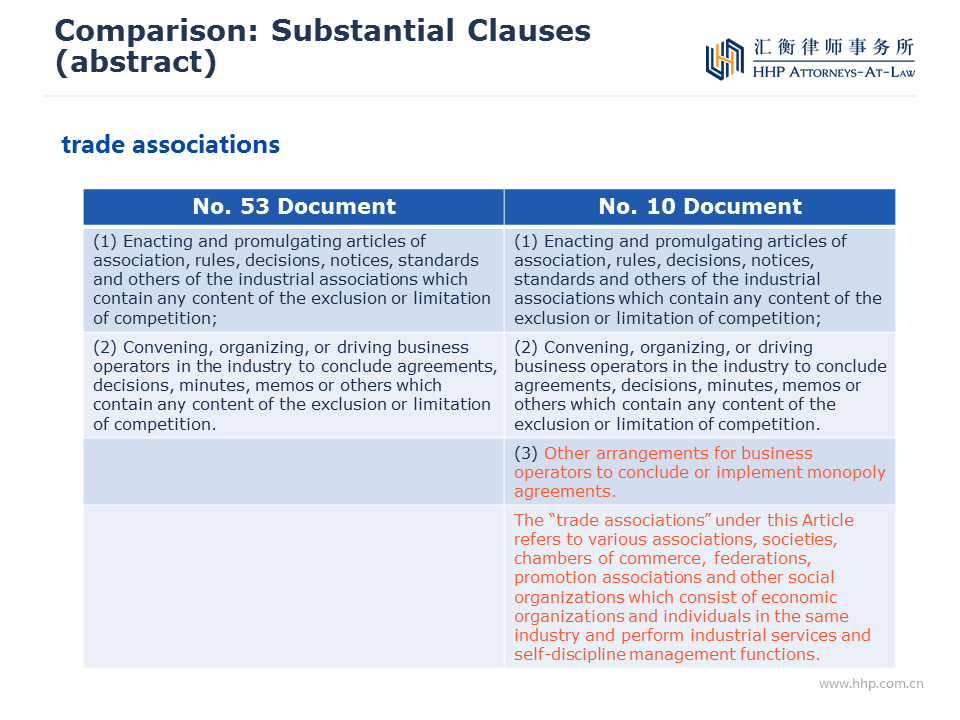
V. Introduction of the Lighter Punishment, Adjusting the Reduction and Exemption Standard of Punishment
According to the No.53 Document, for the non-price monopoly agreements, the first business operator that voluntarily reports the relevant information on the monopoly agreement, provides important evidence, and comprehensively and actively cooperates with the investigation shall be exempted from punishment. In respect to the other business operators that have voluntarily reported to the administrative authorities for industry and commerce the relevant information on the monopoly agreement and provided important evidence, the punishment may be reduced as appropriate. In case of the price-related monopoly agreements, according to the provisions of Regulations on Procedures for Administrative Enforcement of Anti-Price Monopoly, the first business operator that voluntarily reports the relevant information on the conclusion of the price-related monopoly agreement and provides important evidence may be exempted from punishment; as to the second business operator that voluntarily reports the relevant information on the conclusion of the price-related monopoly agreement and provides important evidence, the punishment may be reduced by a range not lower than 50%; for other business operators that voluntarily reports the relevant information on the conclusion of the price-related monopoly agreement and provides important evidence, the punishment may be reduced by a range up to higher than 50%.
After the implementation of the No.10 Document, the above punishment standards will be changed. Please see the following chart for details. Besides, the No.10 Document, in particular, adopts a lighter punishment, that is, if a business operator can prove that it has passively complied with administrative orders to reach a monopoly agreement, it may be given a lighter or mitigated punishment according to law. Such lighter punishment has been mentioned in the Guidelines on Recognizing Illegal Gains Obtained by Business Operators from Monopolistic Acts and Determining the Amount of Fines (Draft for Comments), however, its applicable scope under the No. 10 Document is not as wide as the aforesaid Draft for Comments.
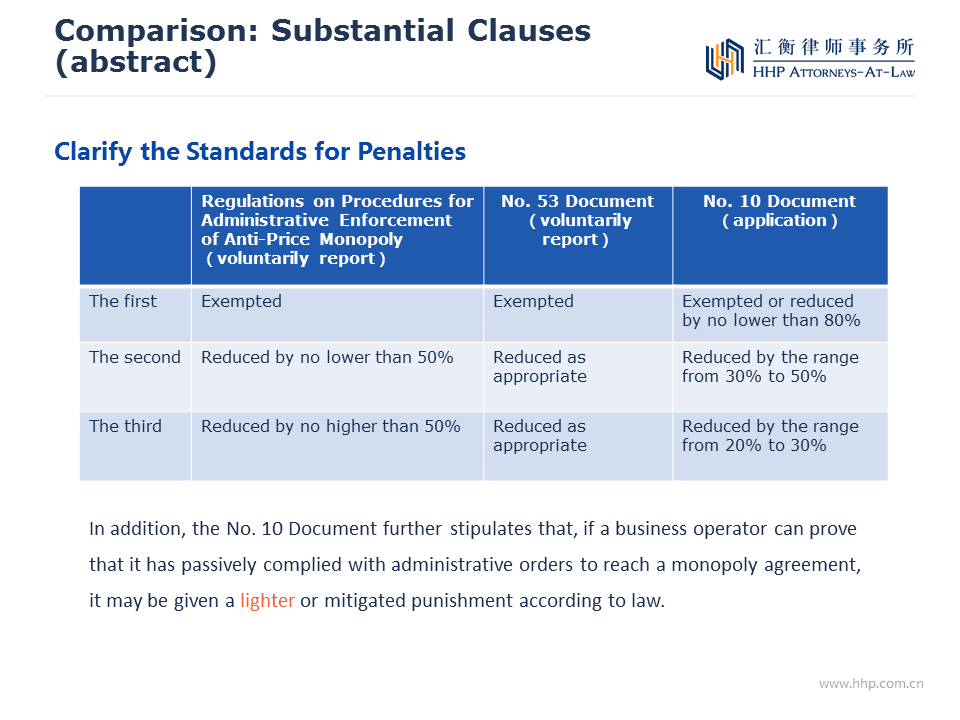
VI. Put aside the “Safe Harbor” System
Previously, in the No.10 Document (Draft for Comments), it provided that “if the agreements concluded between competed business operators have not fixed or changed commodity prices, restricted the amount of commodities manufactured or sold, divided the sales market or the purchasing market for raw materials, restricted the purchase of new technologies or equipment, or the development of new technologies or products, or jointly boycotted transactions and the total market share of the signatory business operators in the relevant market does not exceed 15%, or if the agreements concluded between business operators and their trading counterparts have not fixed the prices of commodities resold to a third party or restricted the lowest prices for commodities resold to a third party and the total market share of the signatory business operators in the relevant market does not exceed 25%, it shall be assumed that such agreements will not eliminate or restrict competition, unless there are evidences to prove that these agreements do eliminate or restrict competition”. However, the aforesaid contents have not been formally adopted in the current No.10 Document. As indicated by relevant authorities, considering the current Anti-monopoly Law has not specified the market share and other elements for the "safe harbor" system, the "safe harbor" system will be left to be further studied and demonstrated in the future.

